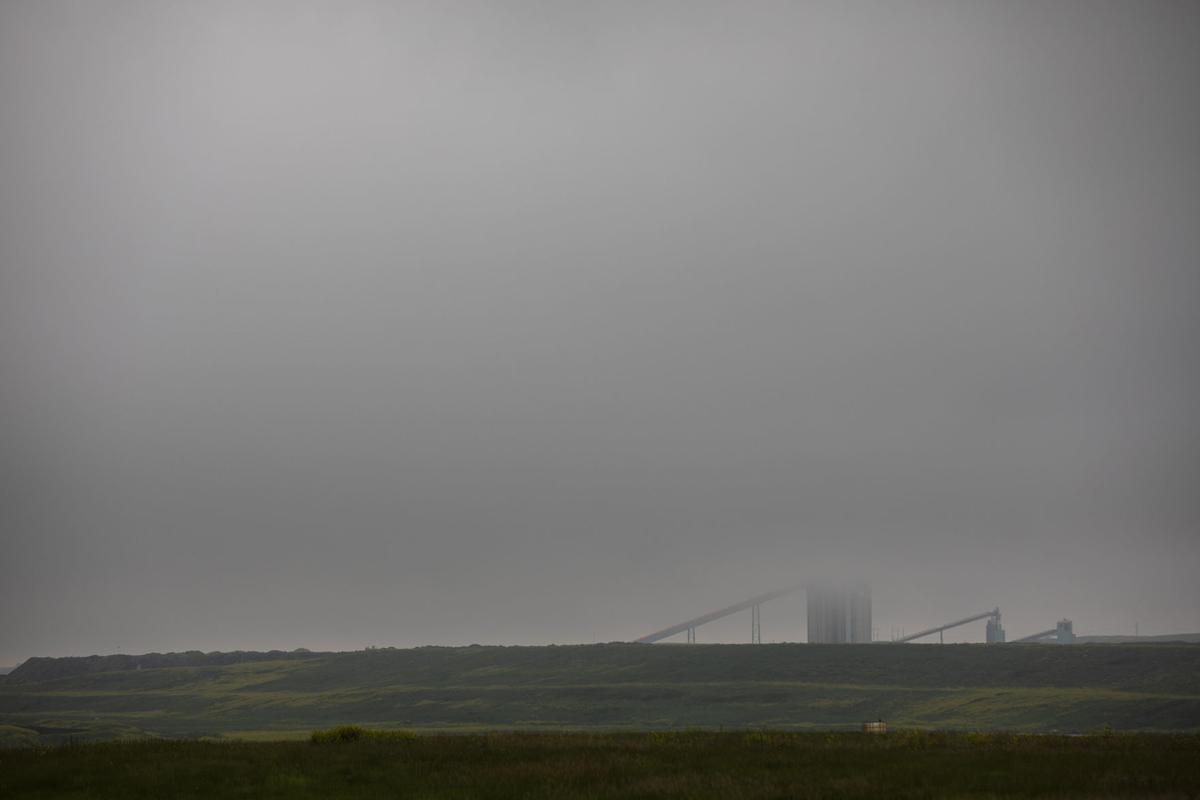The Coronavirus Pandemic Could Accelerate Coal's Decline in Wyoming

By Camille Erickson
May 4, 2020 - Few industries are shielded from the economic wreckage wrought by the COVID-19 pandemic. But those already vulnerable before the deadly virus brought the U.S. economy to its knees are now feeling the financial blows particularly hard. That includes Wyoming’s top industry: coal.
Last month, the largest round of coal mine layoffs in years swept through the Powder River Basin, the state’s epicenter of coal production, with over 300 miners losing their jobs.
Miners working in the energy industry are no strangers to layoffs. The natural boom-and-bust cycle of the energy market causes firms to contract and expand workforces regularly. But this downturn may be different, with the pandemic speeding up the decline of coal production in Wyoming and plunging the workforce into uncertainty, according to interviews with several analysts.
For one, the hundreds of miners let go last month joined over 26,000 fellow Wyoming workers in filing for unemployment benefits in the month of April. Alternate job openings remain few and far between as many state-mandated business closures have brought the economy to a near-standstill.
Wyoming has produced more coal than any other state in the country since 1986, shipping the vast majority of the commodity to customers outside the state’s borders. But it’s no secret that the coal industry was already sinking, showing symptoms of structural decline. Utilities have shied away from coal in favor of cheaper natural gas and renewable energy sources. The Energy Information Administration, the country’s leading energy data agency, predicts more losses will arrive on coal companies’ doorsteps in the coming months. It forecasts the country will produce 22 percent less coal in 2020 compared to last year.

Eagle Butte coal mine is covered by dense clouds in 2019 near Gillette. The effects of the coronavirus pandemic have been felt especially hard by the coal industry.
File, Star-Tribune
Government-initiated steps to quell the spread of the novel coronavirus have led to a swift decline in commercial electricity use, with electricity consumption forecasts falling by 4.7 percent this year. On top of that, the nation had an unseasonably warm winter and some of the coal being mined now is building up in stockpiles, going unused.
“As long as we’ve got this COVID-19-induced recession and surplus of electricity generation, demand for coal is going to be weak — really weak,” said University of Wyoming economist Rob Godby, who has closely tracked the state’s coal industry for decades.
Losses like this in the coal sector have an unusually large ripple effect in Wyoming. For half a century, the Powder River Basin — a 20,000-square mile region in northeast Wyoming — served as the state’s leading economic engine. Lucrative taxes and fees reaped from coal have filled Wyoming’s coffers to the tune of billions of dollars, funding everything from schools to roads. But coal’s golden years have been imperiled, and the pandemic is likely making matters worse.
Wyoming’s Legislative Service Office issued an ominous April 10 memo predicting the loss of anywhere from $35 million to $74 million in revenue this fiscal year and between $68 million and $149 million in revenue throughout fiscal year 2021, just from the slump in coal production at the state’s 16 mines.
To Godby, the Equality State is in deep trouble and needs to rapidly adapt its economy.
“We were in the middle of the ocean in a leaky boat, a long way from port. But we were hoping to get to land before a storm hit,” he explained. “We didn’t just get a storm though, we got a hurricane.”
'Not the Old Boom-Bust Cycle'
The coal industry has faced the threat of shrinking demand for years, well before the coronavirus pandemic and corresponding economic collapse clobbered the U.S. Coal production across Wyoming continued to tumble throughout the start of this year, with output during the first quarter setting a new two-decade low, data released by the U.S. Energy Information Administration shows.
“What this may have done is just accelerate what was going to happen anyway as the coal sector downsized due to national conditions,” Godby, the economist, said.
The first quarter ended on March 31. Since then, the gap in coal production between this year and last has only grown.
For the week ending April 25, Wyoming coal mines produced 20 percent less coal compared to last year. According to research from Rhodium Group, an energy research firm, weak electricity demand is partially to blame. Early last week, coal accounted for a mere 15 percent of the nation’s power generation — “a level not seen before,” according to Trevor Houser, a partner at Rhodium Group. As natural gas prices slide even lower during the pandemic, gas production has risen, along with wind and solar energy, elbowing coal out of the electricity market more.
For three days between mid-March and mid-April, wind and solar generated more power than coal, “for the first time in recorded history,” according to a research note, which was sent to clients of Rhodium Group’s Climate Service and later provided to the Star-Tribune.
“What we have seen over the past month is a rapid acceleration in two trends that were already damaging coal’s market share in the U.S.,” Houser said. “The first was fairly weak electricity demand and the second is increasing competition from gas and renewables. And those two trends are what have reduced coal’s market share from 50 percent to 25 percent over the past 10 years.”
Coal Firms Respond
Understanding how these numbers have hit Wyoming coal firms’ finances can be tricky. Only two companies in Wyoming’s Powder River Basin — Peabody Energy and Arch Coal — are publicly traded and therefore issue quarterly reports. Both Peabody and Arch reported a downturn in sales and revenue during first quarter 2020, compared to the year prior.
“Peabody Energy’s revenues were down over $400 million year-over-year. That’s a pretty significant change — almost one-third,” said Clark Williams-Derry, energy finance analyst at the Institute for Energy Economics and Financial Analysis, an energy transition think tank. “Not a good look at all for this company.”
Net cash for operating activities during Peabody Energy’s first quarter of operations in 2020 also ran into the negatives, coming in more than $200 million short of the same period last year. “This is a sign that a company is in the short-term experiencing severe financial stress,” Williams-Derry noted.
Peabody Energy cited low natural gas prices, weak electricity demand and a curtailment of industrial manufacturing during the pandemic as reasons for the loss in demand for coal, according to a Wednesday news release.
Other coal companies in the Powder River Basin, like Eagle Specialty Materials and Navajo Transitional Energy Company, keep all their finances private.
“What we can’t see, we should probably be worried about, because we know it’s probably a pretty shaky market,” Godby, the economist, noted.
What’s more, capital markets have also been on unstable footing and could remain weak for some time, making maintenance of capital-intensive operations tricky.
Communities Built Around Coal
At a Shell Gas Station located just off Highway 59 in Gillette, a bus transports workers to the coal mines every day, including some of the world’s largest: North Antelope Rochelle and Black Thunder. But fewer miners employed at the mine means less workers waiting at the gas station and fewer customers at the station’s convenience store. Every business— from convenience stores to restaurants and realtor firms — are impacted by the downturn in coal, according to Geno Palazzari, communications manager for Gillette.
“I don’t think there is a portion of our economy that isn’t affected by it,” Palazzari said. “We’re all tied to (the extractive industries) in some way.” The city of 30,000 goes by the nickname “the Energy Capitol of the Nation.”
For the towns built around the coal mines, a majority of residents are connected in some way or another to coal. Often, going to work at the mines is not just a job to many families, it’s an integral part of their identity and culture.
Mayor Ralph Kingan of Wright estimated about 75 percent of families in the town of under 2,000 were connected through employment or business with the coal mines.
He calls the decline in coal demand a probably “new norm” the town will need to contend with. “It could affect Wright quite a bit,” he said. Adding insult to injury, several temporary oil workers in town have left since the pandemic slashed oil prices and caused firms to shut in wells.
“So far, we’re maintaining,” Kingan said. “That’s all we can do. We have a little money saved for the downturn. We should be alright as long as it doesn’t last forever.”
According to a coal miner at the North Antelope Rochelle mine, “the writing was on the wall,” when it came to the mass layoffs. The worker asked the Star-Tribune to remain anonymous for fear of retaliation from the company. He was not subject to the latest round of layoffs, but was saddened to lose so many co-workers and worries the smaller workforce could lead to more accidents and injuries.
“This layoff was not quite a shock,” the miner said. “It would’ve come with or without the COVID-19 issue. Most people knew that we had too many people for the amount of tons of coal that were shipping. The general consensus is there may be another layoff soon.”
Between the slowdown in production and the declining number of trains departing the basin, “It’s not rocket science to see that there’s a huge problem in the coal industry and more pain to come,” the miner said.
There could be a small silver lining for coal down the road, after the country weathers the storm of the pandemic.
Some predict a year or two from now, coal could elbow back into the electricity market given the recent collapse in oil. Oil prices have been devastated by the novel coronavirus, plunging to historic lows. Producers have had no choice but to shut in wells and halt production given the glut of oil around the globe during the pandemic.
When operators drill for oil, natural gas comes up to the surface in the solution, too. So less oil drilled means less natural gas on the market. Contracting the supply of gas could inch up prices for the commodity, making coal a bit more attractive to energy suppliers, according to the economist Godby.
“I wouldn’t call it a silver lining, but a maybe slight reprieve,” he said. “Nothing to write home about.”
In the meantime, several industry leaders continue to tout carbon capture technologies or carbon products as a potential lifeline for the state’s coal mines. Regardless, Travis Deti, executive director of the Wyoming Mining Association, is intent on keeping every single mine open and operating.
“We’re relying on the mining industry to pay some bills in this state and we got to keep up and keep operating, and going to work every day,” Deti said.
“It’s critical that we keep up and operating,” he added. “Because as you look at the state of Wyoming and our revenue picture, you know those severance taxes, royalties and fees from coal and all mine products are going to be more critical than ever right now. Especially with the dreadful condition of the oil and gas, the state needs the industry right now.”

